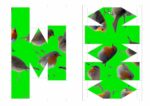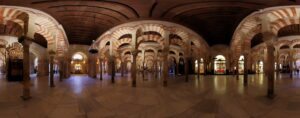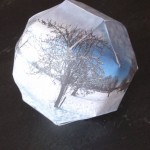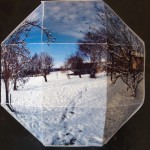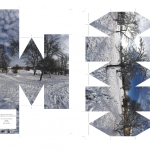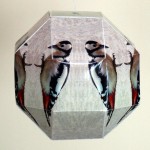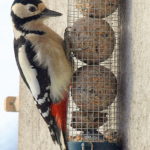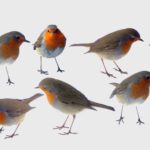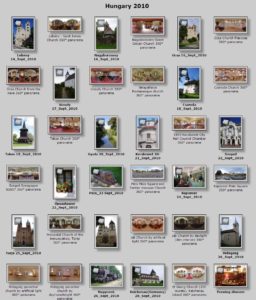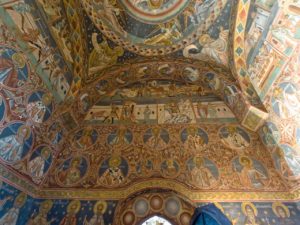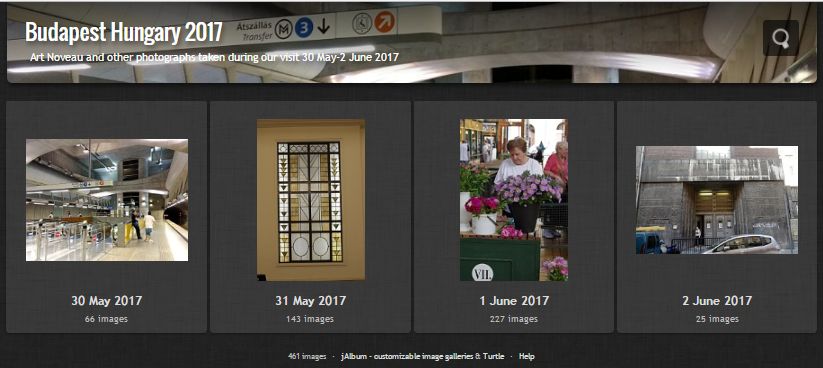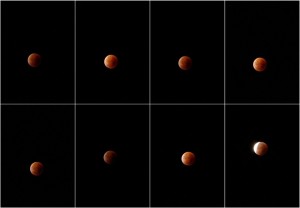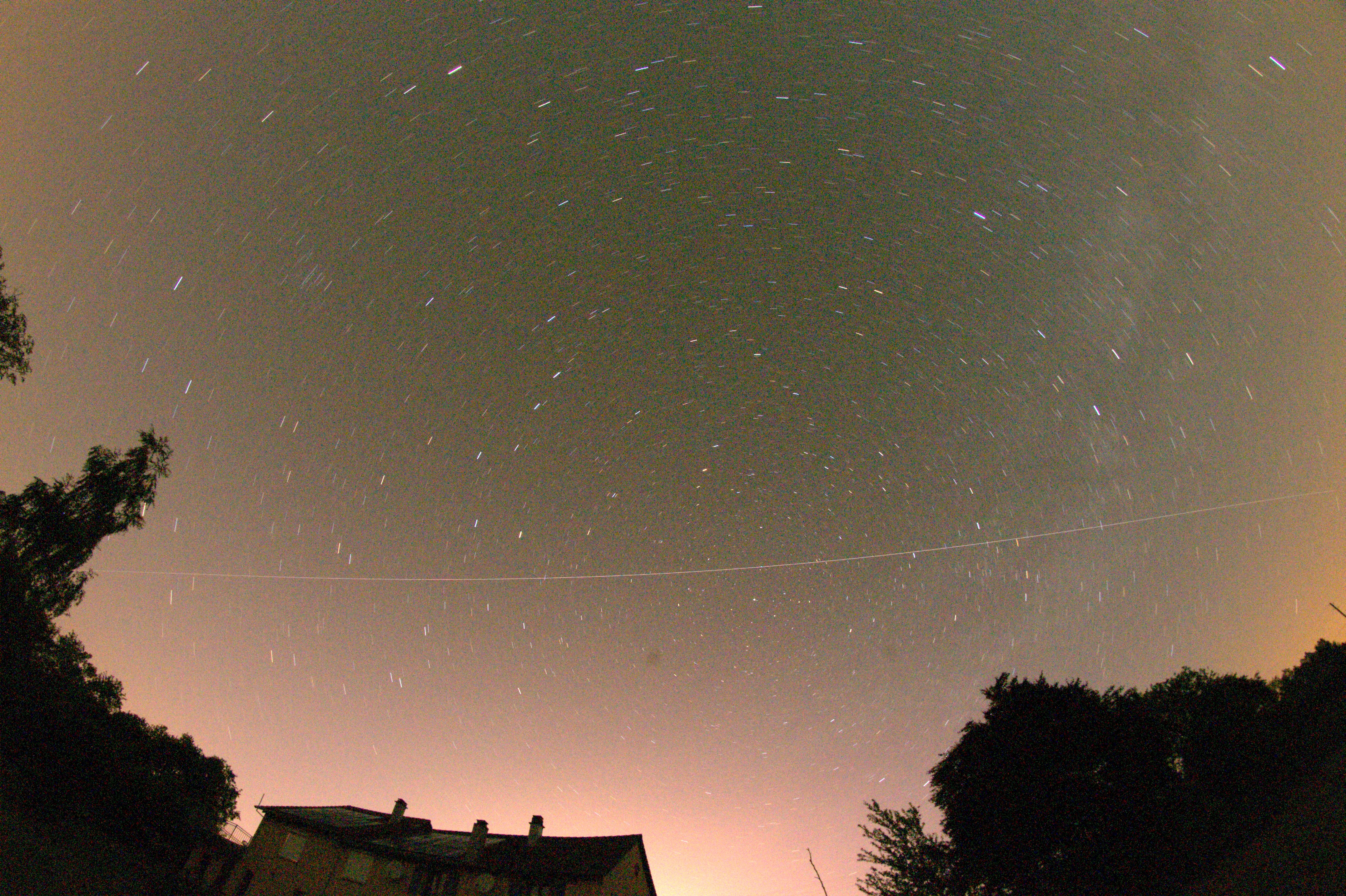To download a printable PDF version click on this link
E2E2012_issue_2-A.pdf (six A4 pages)
And some links giving more photos than are in the text:
A lot of crépi – day-by-day progress
Restaurant meal photos
A siege mentality sets in as the horizons shrink, with the hills blotted out by low rain clouds like a Japanese painting, and doorways and windows sealed off with sticky tape and polythene. No, we are not being immured due to a bubonic plague outbreak; at the moment we can still get out down the ramp and into the wet field, or out of the back barn door if we are prepared to squeeze round grubby scaffolding poles. The crépi men have arrived! So a good time to retreat to the attic and send an update on the past months here.
Over the years we have been trying to turn parts of our fields into a peaceful garden and (more ambitiously) an arboretum, whilst the farmers continued to carve deep ruts across the middle of it all with increasingly heavy farm machinery rather than using the little tractors of twenty years ago. With the help of the area conciliator (a gentle legal functionary), a sensible solution has now been reached: to create a new track at each end of our fields to give access to their lower fields and to replace the one close to the house. We phoned de Freitas, who did all the earlier building work here. He was rumoured to be living sullenly in retirement, having argued with his sons, and even (gestures of hand to mouth) drinking heavily. His wife was a little guarded on the phone, but when he came round to see us, he was all smiles and affability and perfectly prepared to use his mechanical digger on a morning’s work for old clients. So his son ordered two 6 metre long pipes to create bridges over the ditch at the bottom of our fields and onto the bottom fields and he duly shifted earth to make a good slope and track to the “bridges”. At one point the digger fell silent and we could see de Freitas standing by the ditch looking gingerly at an object he’d unearthed.

Was this a WWI grenade?
Was the elongated rusty object a grenade from the first world war (after all, soldiers had died in these fields) or was it a bottle-shaped container or bit of agricultural machinery? We did the correct thing for suspect grenades and consulted the mayor, who, unruffled, took it away and wasn’t seen for a few days. No more was said, so we assume it just went in his dustbin!
Anyway (and this is increasingly a shaggy dog story to while away a damp day), we took the opportunity to consult de Freitas about two projects that had been on our mind for a while. Not surprisingly, he has a colleague who would happily tarmac our car parking areas and the narrow strip between the road and house (which got very muddy this winter), and another who renders the outsides of houses, old or new. It would seem that business cannot be discussed without the correct introductions. So one morning he brought over his friend and neighbour, M. Meltz, who could do the re-rendering (crépi) and introduced him. But it would have been impolite to get down to the nitty gritty so soon after introductions. So M. Meltz promised to ring and arrange an appointment to survey the house and discuss the project. That done, an estimate prepared and accepted, M. Meltz was prepared to start work in September, when the weather would be cooler, and expected work to take up to four weeks, depending on the weather.
After this rather leisurely start to the project, we were peacefully showering one morning at the end of May (admittedly at the rather late hour of 10 a.m.) when the doorbell rang. Expecting it to be a delivery (John is always ordering bits and pieces off the internet), I wrapped a towel round me and went down, to be greeted by a rather embarrassed M. Meltz wondering if they could do the crépi work in June rather than September. Had another contract been postponed, we wondered, or was it that the wet, cool forecast favoured June working? Five days later the scaffolding arrived, followed by two days of noisy pneumatic hammers as the old rendering was chipped off and the old stones revealed.
John has always suspected that the old farmhouse, like most of the other old local buildings, would have originally had a front door onto the road, next to the big barn entrance.
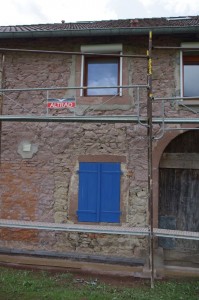
Bricked up farmhouse door
And sure enough, a bricked up doorway was uncovered, next to the present downstairs bathroom window (where the shower now is). Interestingly the stones in that section are pinker, and it looks as if they formed the original building comprising barn and probably a front and back room with the traditional large Vosgian chimney in the middle (above and behind the farmhouse fridge). The stones on the upper storey are larger and more regular than the lower courses, so it may originally only have been a single storey building. Later a grander entrance and rooms were added to the east and a extra barn for animals and a hayloft to the west. We’d been told that our predecessor, M. Fresse had added the third barn for vehicles (and presumably the workshop for his electrical repair business). We of course have extended above his third barn and created a garage between that and his workshop. It has been fascinating to see the sequence in the stones, bricks and breeze blocks. I only wish we could keep the attractive stonework, despite all its blemishes, but the “mortar” holding the stones together is more like dried, crumbling mud at the barn end and definitely needs strengthening and weatherproofing with enduit, a mix of cement and chalk.
They have now applied the undercoat of enduit on the north wall along the road and the east wall by the later front door and are currently working on the south wall, with the west section (third barn, garage and workshop) still to be done. It is a three- (and sometimes four-) man job. The apprentice (who managed to injure his finger with the drill on the first day and needed a large white bandage) stands by the mixer feeding in the bags of powder and water, the foreman wields the nozzle of the long flexible tube, spraying the mix between and over the old stones to a rough finish, which clings remarkably well, and his number one smooths it expertly to a good finish. Everything not being sprayed is being covered in polythene sheeting and orange tape. It’s fascinating to watch, – we stood for ages on the first day, dripping in the rain, to gawk, before clambering back indoors for a coffee. Later (in fine weather) a colour coat will be applied. Over in Alsace you can see lurid raspberry, mauve, turquoise and lemon shades, but we’ve gone for a traditional peasant ochre with a mud grey strip at the bottom to deal with the mud of passing cars, tractors and milk lorries.
Speaking of milk lorries, during the conciliation process (above) we met a delightful old man who used to collect the milk from our little farm in the old days, along with that from the neighbouring farms. He would sell it on to thirty-seven small shops in St Dié, he said, and later to the laiterie until it closed. Now it is collected by a tanker, which has to slow down to get past our scaffolding at present.
But ours aren’t the only major works in the village. New houses continue to be built despite the recession (and lack of reliable water sources). The latest is Farmer Duhaut’s. Since his retirement from active farming (partly due to an accident or two with a bull) he no longer needs his barns and hangers, so most have been pulled down this winter and two new single buildings are spreading out. His mother, Giselle, still lives on the ground floor of the old farmhouse while he and his wife live above, but it sounds as if the stairs were getting a bit much. Work is still not complete on Ludo’s car-repair garage between his house and Granny and Grandpa Laine’s house, but there is no shortage of cars outside awaiting ordered spare parts. Apparently in spring he also had about fifty motor mowers awaiting parts. The Vozelles (the farm where the dogs, hens, geese, chicks and cats spread out over the road as their farmyard) have had the front of their house painted cream and grey. And the house on the road into the village which used to be a small metal factory and which Duhaut’s former farming partner, Olivier, turned into a family house, is now surrounded by a new wall and occupied by a man with a fish delivery business. According to the Vozelles that house was burgled in broad daylight one morning. I wonder if the thieves made off with the usual items or if it was a fish heist.
Mention of fish leads my thoughts to restaurants. Some of you have hinted that we spend most of our days in restaurants, but really, dining out remains an occasional treat for us (it’s just that we tend to harp on about it). We enjoyed seeing Raymond Blanc’s progress through France on TV, especially in Alsace, where he cooked in a restaurant in Riquewihr that we knew. We were rather sad when our favourite chef moved from the Blanche Neige (which is still empty up on its hillside) to a restaurant close to the Rhine, and even sadder when he later moved even further east across the Rhine into Germany. He and his wife now run the Heckenrose Hotel and its restaurant, close to Europa-Park (so rather a different family-based clientèle much of the time). However we made the long trek across the Rhine one Sunday lunchtime in April and had a wonderful five-course meal (no mid-week lunchtime opening as the Germans don’t have the two-hour lunch break so sacred to the French). We made a day of it, stopping at what we thought was just a wine fair en route, but which was an interesting (and unique?) combination of graphic illustrators/publishers and wine producers. And on the way back we took the car ferry across the Rhine. We had asked if their sous-chef was still with them; but, being a Ukrainian his temporary work permit meant he had to stay in France unless he wanted to restart the whole procedure again, so he was now at a restaurant in Ribeauvillé. So, of course, we had to try that too. I was expecting the Restaurant Parc Carola to be very elegant, but it turned out to look like an Edwardian tea house in the small park next to the Carola bottled water factory. But the food was quite enjoyable. The chef had previously had a Michelin star for many years at a restaurant in Colmar but was now starting out on her own. For elegant we had to wait for a trip to a somewhat larger park, the Jardin de l’Orangerie, in Strasbourg (close to the European Parliament) and the Michelin-starred le Buerehiesel restaurant. The son has simplified the restaurant (and reduced prices) since his father’s day, but if you want classic cooking and silent flunkeys attending to your every whim, this is still the place. There were busy tables outside, but we were ushered to an attractive first-floor room with huge glass windows reflecting the trees of the park.

A street of storks in Strasbourg
We’d been dive-bombed by a stork on our way across the park, but it wasn’t till we were returning to the avenue where Bluto was parked that we noticed that every pollarded tree along the avenue had a stork family in comically detached splendour similar to the detached villas behind.
But the highlight was my birthday meal in a little restaurant on the Rue des Juifs just inside the old walls of Riquewihr. I had been thinking of going back to the Table du Gourmet where Raymond Blanc had cooked until John found the reviews for au Trotthus. This sounded like somewhere that would appeal to all six of us (Leila and a friend, Emma, were over with us for the week and Roger and Dorinda were staying in their Anould house). The Breton chef had worked for twenty years in Japan, Australia and the Caribbean, before deciding to poser ses marmites in Alsace, bringing with him the flavours of the world. Ignoring the chalked plateau gourmand menu of the day we tried different dishes from the more elaborate menus and were all full of praise. The perfect birthday meal! In fact it must be time for a return trip.
Leila planned a busy programme to show Emma the best of both sides of the Vosges, and for once the weather was good for most of her stay. We drove north on their first day to Lunéville for an upmarket vide grenier which included antiques stalls. We had a great time browsing, with everyone finding something of interest. Leila was the first to spot a low table with blue tiles which would look good in her little garden. Despite bargaining, it was a bit pricey. Later she found a slab of more attractive blue tiles (which would once have formed a base for a wood-burning stove) and she got both that and some attractive Moroccan-tiled shelves (for trailing pot plants) for a lower price. Meanwhile Emma rummaged and we haggled for an attractive tablecloth, John noticed an “Alice” (Wonderland and Looking Glass) in French, beautifully illustrated by Dušan Kállay from Bratislava, and I bought a paperback version of Ogden Nash poems produced for the American soldiers in the last war (and presumably left behind during the Liberation). We wandered down to the Lunéville château which is still partially shrouded in scaffolding, though it the fire-damaged section has been rebuilt, and back through the formal gardens, finishing our visit with sausage and chips at the flea market. We had equally enjoyable days in the Alsace villages of Kaysersberg and Riquewihr looking at all the local crafts like earthenware casseroles and embroidered linen and more exotic ones like “vegetable ivory” jewellery; we ate hearty Alsace food at the Auberge Saint Alexis up in the forest as well as more delicate food of au Trotthus. The girls spent a day at the concentration camp at le Struthof, and we had a local tour (the only damp, grey day of their stay) of the tiny Plainfaing antique shop (where Emma bought an enamel jug) and the Confiserie des hautes Vosges where pine, menthol and herbal flavoured boiled sweets are made; Lac de Longemer looked cold and uninviting so we moved on to one of the many linen shops around Gérardmer, lingering over pretty heart-embroidered window panels. After English Sunday lunch (French style) we drove them back to the airport, stopping at a last vide grenier. This was definitely less picturesque than Lunéville’s, but John found an old Photax bakelite camera at a sensible price, I got a new grey sun-hat, and the master stroke was spotting some wrought iron legs for the Leila’s tiled table-top. (We won’t have as much room in the car for wine on our next trip back to the UK!) As we were leaving, John fished an attractive ceramic plate out of a rubbish bin and it now hangs on a previously bare bit of garden wall.
By now you must be asking what about the usual DIY sagas without which no newsletter would be complete. John finally got round to converting a sofa he’d made in the early seventies into an armchair to match the one that he’d made at the same time. We’d bought some foam cushion pads back in Nottingham on our last visit and I made some covers for them. The first set were off-white covers, similar to the original ones. But, after Toby had pointed out a patterned fabric in the Conran exhibition at the Design Museum, which he remembered us having in his youth, I fished out the faded remains of the fabric from one of our many boxes, and had just enough good material to cover the foam for both chairs. So now they’re more practical, but still attractive, russet shades that match our current sofas. The day after Leila and Emma left, I boxed up some of our books and ornaments so we could move their shelves from the wall for the next projects, which were to be accomplished with the help of Alistair, whose annual working visit has become absolutely invaluable. Number one task was to put up the new roller shutters outside above the windows (we didn’t then know how soon M. Meltz’s gang would be taking them down again). Their second task was to create channels behind the plasterboard walls for the electrical wiring to the shutters and then drill through the walls to attach the wires. White plasterboard dust everywhere and much frustration, but eventually it was all done and the roller blinds (when not dismantled) glide smoothly up and down, operated by remote control from inside. Alistair and John also laid more drainage channels across the front of the house, so, when the sloping strip from the road to the house is tarmaced, the surface water will flow to the drains. Across the back of the house and under the drive they sunk another pipe for a trickle-watering system (to be finished later) for the vegetable garden and finished the concrete tiling on the slope and water tank next to the terrace. An instantly attractive effect was gained when Alistair laid a new stretch of curving brick path from the end of the terrace (which they paved last summer) to the previous path through the small flower garden. (Will next year’s projects include a link from the other end of the path to the foot of the ramp? Having got one incorrect batch, we must remember that the correct bricks are apparently called “zebras”) We were sad to wave Alistair off at the end of ten days of hard labour as we missed his cheerful presence, ingenious ideas, flamboyant fungi-related flea market purchases and hard work (not to mention those early mornings and evenings of model helicopter flying).
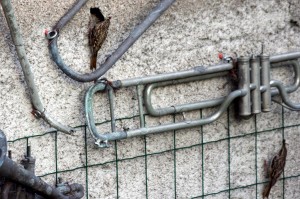
Treecreepers and trumpets
The local wild life will also miss Alistair. He was fascinated to observe treecreepers scuttling up and down the wall above the flowerbed and new path to a tiny hole and he would break off work at intervals to allow the treecreepers to approach their nest. Other birds will also miss the house walls for nesting as all the crevices are filled with enduit. The redstarts have been perching, puzzled on the scaffolding. We shan’t regret the wasps moving out of the crumbling mortar, and hope the new coating will defeat the tunnelling rodents. The very top of the walls under the eaves have not yet been completely sealed to prevent any further stone martens, though John’s initial chicken wire has so far done the trick. The local roe deer are picturesque, though one gave Leila quite a fright as it leapt across the road right in front of Snowy (car) as she was driving. Sadly we haven’t been able to prevent them from damaging the succulent young trees in the arboretum.
And while all this everyday trivia has been going on, there have also been the far more important elections here. Before the first round of presidential voting, the only election propaganda we received was from Marine Le Pen and its lucid, reasonable employment and welfare proposals might well have convinced many locals that this was no racist, far right agenda (though it did lack any indication of how it would all be funded). At the pensioners’ barbecue we went to last week, the main concern seemed to be the unmarried status of their new President’s first lady who wouldn’t be allowed to stay with the Queen, though François Hollande was otherwise seen as a Good Thing. In fact our fellow diners seemed far more interested in our Queen’s Jubilee celebrations than the republic’s elections. An impassioned appeal then arrived in our letter box to support our current UMP Deputé, Gérard Cherpion, in the elections for the National Assembly (in which we can’t vote, either); we were urged not to be seduced by an outsider, – a champagne socialist with no Vosgian heritage, Vosgian experience or concern for the Vosges (though the name of Jack Lang was not specifically mentioned, or his Ministerial experience – or the fact that he was in fact born in the department of the Vosges). The leaflet obviously worked as Jack Lang won only 49.1% of the vote.
So with France in the hands of Hollande, the Vosges continuing to be represented by Cherpion, and the outside of our house in the hands of the crépi men, we’ll sign off with the latest photo of a far more significant young man. (It seems a long time since we were over for his first birthday in March).
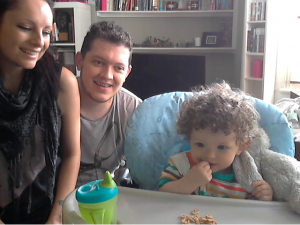
Stella, Toby and Jacob 17 June 2012
A bientot!
